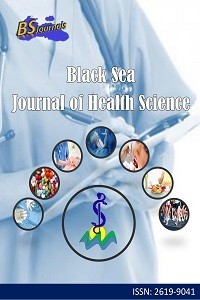Mikrobiyotanın Enfeksiyon Hastalıklarındaki Rolü
Mikrobiyota, Disbiyoz, Fekal mikrobiyota transplantasyonu, C. difficile, HIV
The Role of Microbiota in Infectious Diseases
Microbiota, Dysbiosis, Fecal Microbiota Transplantation, C. difficile, HIV,
___
- Agrawal M, Aroniadis OC, Brandt LJ, Kelly C, Freeman S, Surawicz C, et al. 2016. The long-term efficacy and safety of fecal microbiota transplant for recurrent, severe, and complicated Clostridium difficile infection in 146 elderly individuals. J Clin Gastroenterol, 50(5): 403-407.
- Anwar H, Iftikhar A, Muzaffar H, Almatroudi A, Allemailem KS, Navaid S, et al. 2021. Biodiversity of gut microbiota: Impact of various host and environmental factors. BioMed Res Inter, 2021: 5575245.
- Bilgiç Z, Kayaaslan B. 2021. HIV ile yaşayan bireylerde kronik enflamasyon ve mikrobiyota ilişkisi. Ankara Üniversitesi Tıp Fakültesi Mecmuası, 74(1): 10-16.
- Bosco N, Noti M. 2021. The aging gut microbiome and its impact on host immunity. Genes Immun, 22(5-6): 289-303.
- Burke KE, Lamont JT. 2013. Fecal Transplantation for Recurrent C lostridium difficile Infection in Older Adults: A Review. J American Geriat Soc, 61(8): 1394-1398.
- Demirci H. 2019. Fekal Mikrobiyota Transplantasyonu. Tıp Fak Klin Derg, 2(4): 127-129.
- Dinh DM, Volpe GE, Duffalo C, Bhalchandra S, Tai AK, Kane AV, et al. 2015. Intestinal microbiota, microbial translocation, and systemic inflammation in chronic HIV infection. J Infect Dis, 211(1): 19-27.
- Ellis JL, Karl JP, Oliverio AM, Fu X, Soares JW, Wolfe BE, et al. 2021. Dietary vitamin K is remodeled by gut microbiota and influences community composition. Gut Microbes, 13(1): 1887721.
- Gupta S, Allen-Vercoe E, Petrof EO. 2016. Fecal microbiota transplantation: in perspective. Therap Adv Gastroenterol, 9(2): 229-239.
- Huttner BD, De Lastours V, Wassenberg M, Maharshak N, Mauris A, Galperine T, et al, 2019. A 5-day course of oral antibiotics followed by faecal transplantation to eradicate carriage of multidrug-resistant Enterobacteriaceae: A randomized clinical trial. Clin Microbiol Infect, 25(7): 830-838.
- Jandhyala SM, Talukdar R, Subramanyam C, Vuyyuru H, Sasikala M, Reddy DN. 2015. Role of the normal gut microbiota. World J Gastroenterol, 21(29): 8787.
- Kamada N, Seo SU, Chen GY, Núñez G. 2013. Role of the gut microbiota in immunity and inflammatory disease. Nature Rev Immunol, 13(5): 321-335.
- Khanna S, Pardi DS, Jones C, et al. 2020. RBX7455, a room temperature-stable, orally-administered investigational live biotherapeutic, is safe, effective, and shifts patients’ microbiomes in a phase 1 study for recurrent Clostridioides difficile infections. Clin Infect Dis, 73(7): e1613-e1620.
- Kim KO, Gluck M. 2019. Fecal microbiota transplantation: an update on clinical practice. Clin Endoscop, 52(2): 137-143.
- Lloyd-Price J, Abu-Ali G, Huttenhower C. 2016. The healthy human microbiome. Genome Med. 8(1):1–11.
- Lu W, Feng Y, Jing F, Han Y, Lyu N, Liu F, et al. 2018. Association between gut microbiota and CD4 recovery in HIV-1 infected patients. Front Microb, 9: 1451.
- Martín-Peláez S, Cano-Ibáñez N, Pinto-Gallardo M, Amezcua-Prieto C. (2022). The impact of probiotics, prebiotics, and synbiotics during pregnancy or lactation on the intestinal microbiota of children born by cesarean section: A systematic review. Nutrients, 14(2): 341.
- Napolitano M, Covasa M. 2020. Microbiota transplant in the treatment of obesity and diabetes: current and future perspectives. Front Microbiol, 11: 590370.
- Nicco C, Paule A, Konturek P, Edeas M. 2020. From donor to patient: collection, preparation and cryopreservation of fecal samples for fecal microbiota transplantation. Diseases, 8(2): 9.
- Qin J, Li, R, Raes J, Arumugam M, Burgdorf KS, Manichanh C, Wang, J. 2010. A human gut microbial gene catalogue established by metagenomic sequencing. Nature, 464(7285): 59-65.
- Reygner J, Charrueau C, Delannoy J, Mayeur C, Robert V, Cuinat C, Kapel N. 2020. Freeze-dried fecal samples are biologically active after long-lasting storage and suited to fecal microbiota transplantation in a preclinical murine model of Clostridioides difficile infection. Gut Microbes, 11(5): 1405-1422.
- Ryan MJ, Schloter M, Berg G, Kostic T, Kinkel LL, Eversole K, et al. 2021. Development of microbiome biobanks–challenges and opportunities: (Trends in Microbiology 29, 89–92; 2021). Trends Microbiol, 29(4): 378.
- Salami M. 2021. Interplay of good bacteria and central nervous system: cognitive aspects and mechanistic considerations. Front Neurosci, 25.
- Schären OP, Hapfelmeier S. 2021. Robust microbe immune recognition in the intestinal mucosa. Genes Immun, 22(5-6): 268-275.
- Serrano-Vıllar S, Talavera-Rodríguez A, José Gosalbes M, Madrid N, Pérez-Molina JA, Elliott RJ, et al. 2021. Fecal microbiota transplantation in HIV: A pilot placebe-controlled study. Nature Communicat, 12(1): 1-13.
- Uygun A. 2017. Fekal Mikrobiyota Transplantasyonu (FMT). J Biotechnol Strat Health Res, 1: 132-140.
- Wu J, Wang K, Wang X, Pang Y, Jiang C. 2021. The role of the gut microbiome and its metabolites in metabolic diseases. Protein Cell, 12: 360-373.
- Yayın Aralığı: Yılda 4 Sayı
- Başlangıç: 2018
- Yayıncı: Cem TIRINK
Muhammet Ali ORUÇ, Şule ÖZDEMİR
Relationship Between Trunk and Lower Extremity Muscles and Balance in Multiple Sclerosis Patients
Fatma ERDEO, Ali Ulvi UCA, Neslihan Altuntas YILMAZ, Ahmet Furkan DOĞAN, Ahmet ŞİMŞEK
Sağlık Algısı ve Yaşam Doyumu Bağlamında Koronavirüs Anksiyetesi
Taner TUNÇ, Hasan Fehmi DEMİRCİ, Murat ŞAHİN
Mikrobiyotanın Enfeksiyon Hastalıklarındaki Rolü
Miyozite Neden Olan Parazitler
Süleyman Kaan ÖNER, Sevil ALKAN ÇEVİKER, Numan KUYUBAŞI
Acil Durumlarda Değişen Beslenme Alışkanlıkları, Besin Hijyeni ve Anksiyete
Sevde KAHRAMAN, Emre MANİSALI, Eslem KARSLI, Fatma ÇELİK
Body Mass Index in Women is Related to Eating Behaviour, Addictive Eating and Depression
Pınar GÖBEL, Begüm Defne ŞAFAK ERBAĞ
Retrospective Analysis of 48 Patients Reoperated for Carpal Tunnel Syndrome
